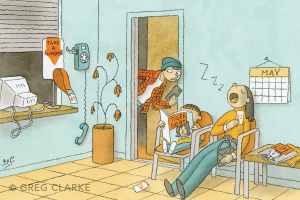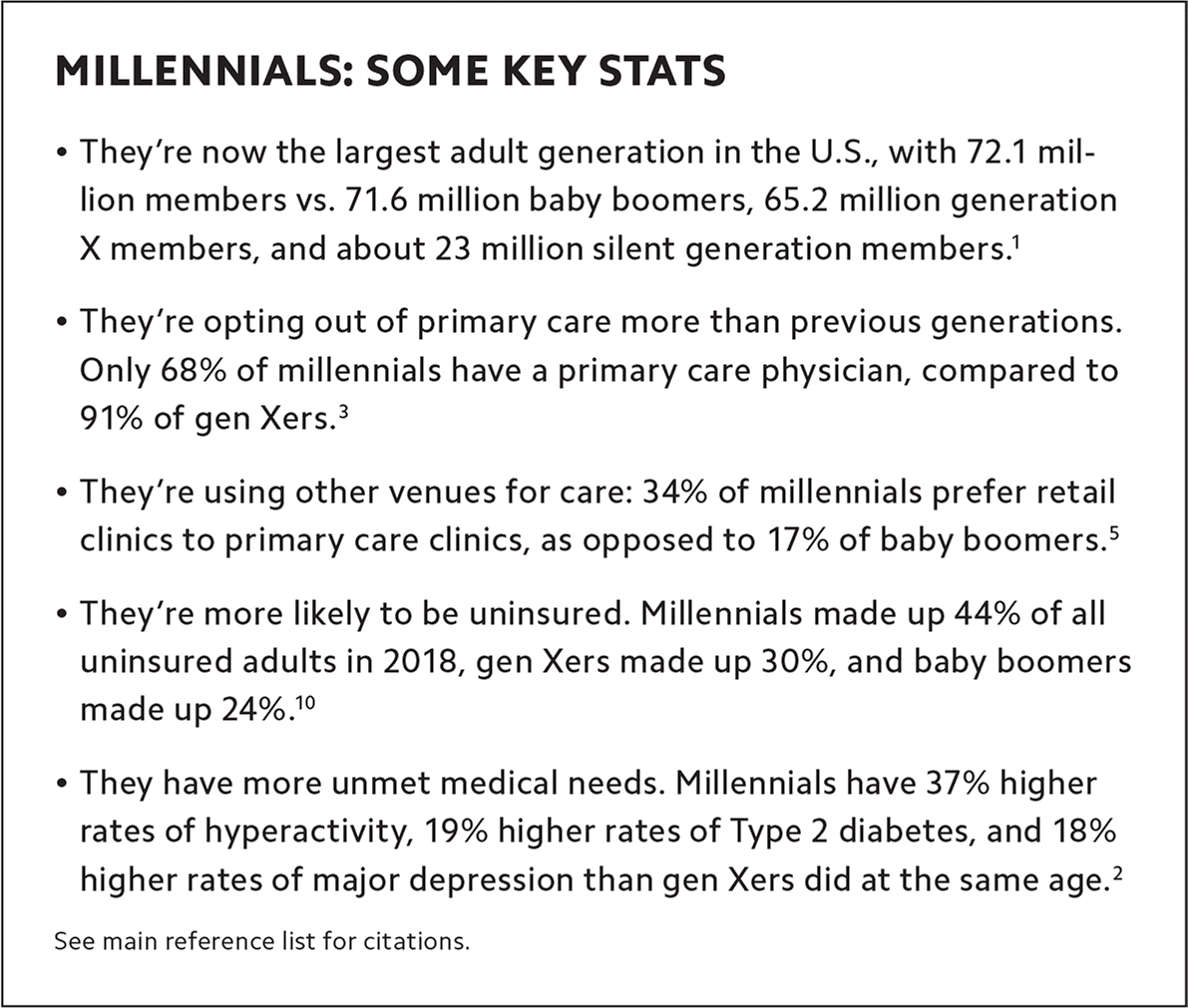
As the largest adult generation in the U.S., millennials will have an outsized impact on the future of health care. Here are some ways to make primary care more appealing to all patients, including the first group raised with the internet.
Fam Pract Manag. 2021;28(3):29-33
Author disclosure: no relevant financial affiliations disclosed.

Family physician Natasha Bhuyan, MD, was out to brunch with a group of friends, all millennials, when two of them began discussing their pregnancies. Others in the group who had already had children piped up with advice about what to expect during delivery, and about the safety of anesthesia and vaccines, based on their own experiences and what they had read online. Bhuyan and another doctor in the group were quiet, until one of their friends brought the spirited conversation to a screeching halt.
“You guys do realize we have a family physician and a pediatrician here who probably best know the answers to your questions,” that person said.
For Bhuyan, the conversation reinforced concerns about whether her generation values medical advice from the internet, friends, and personal experiences more than the go-to source for previous generations: their personal physician.
Millennials (people born between 1981 and 1996) are now the largest adult generation in the U.S., and the viability of primary care practices going forward will depend more and more on attracting this generational juggernaut.1
But there is mounting evidence that millennials as a group do not value primary care physicians as much as previous generations. “The Health of Millennials,” a 2019 study by the Blue Cross Blue Shield (BCBS) Association, found that only 68% of millennials had a primary care physician,2 as opposed to 91% of those belonging to generation X.3 A Kaiser Family Foundation poll conducted in 2018 found similar results.4
How do primary care physicians bring this age group into the fold? This article contains some research-based insights into what millennials want and some ideas about how family physicians can deliver it in ways that will make their clinics more appealing to patients of all ages.
KEY POINTS
Millennials are now the largest adult generation in the U.S., and polling shows they are less likely to have a primary care physician than other generations.
To bring in more millennial patients, practices should consider expanding telehealth options, offering more flexible scheduling, being as transparent as possible about pricing, and integrating mental and behavioral health into primary care.
Online marketing is key to attracting millennials. Having a social media presence allows doctors to show a bit of their personality and “bedside manner,” while displaying clinical expertise about health issues that are common among millennials.
WHAT MILLENNIALS WANT
Millennials tend to consider the traditional system of primary care — calling the doctor's office and making an appointment to be seen in-person days or even weeks later — outdated and inconvenient.7
The generation is marked by the influence of the internet. Millennials are comfortable gathering health information online and communicating virtually rather than face-to-face. They're intolerant of delays and crave instant feedback.8
These factors form what millennials want from primary care. Surveys show that they want it to be quick and convenient, with online access and walk-in appointments,9 and they value extended weekday hours slightly more than weekend availability (perhaps because they're less likely to have children, and the evening activities that often accompany them).6
In addition to wanting convenience, millennials also want value in health care. The Great Recession (2007–2009) stunted the generation's career growth, and they're more likely to be uninsured than other age groups.10 Those who are insured have come of age in an era of rapidly rising deductibles. Unsurprisingly, millennials are cost-conscious health care consumers.6
Jay-Sheree Allen, MD, is a family physician in central Minnesota who was born in 1989 and now hosts a podcast called Millennial Health. She said that to attract millennial patients physicians have to make their services accessible, in terms of both time and money.
Millennials want convenience and value, she said, but they're also yearning for the collaborative, close relationship that primary care physicians can provide.
Allen said the questions she fields most often from her millennial friends and patients are about things like birth control, sexual health, and mental health — topics they consider too personal to discuss with a randomly assigned urgent care provider, and often too individualized to find useful answers online. These topics, Allen said, are perfect for the primary care doctor.
“If you want a consistent and reliable presence in your life, we are that consistent and reliable presence,” Allen said. “We'll be there when you need us.”
Polling indicates that millennials want that presence. Despite all their digital connectedness, one in five millennials in a 2019 survey reported having no true friends.11 A separate survey found that if primary care clinics offered help with loneliness (“help finding friends and social activities”), millennials would be more likely than any other generation to take them up on it.12

|
HOW TO DELIVER WHAT THEY WANT
There are ways to provide the type of services millennial patients want without totally revamping your practice.
Make visits quick, convenient, and flexible. If the COVID-19 pandemic has caused you to ramp up your use of virtual visits, then you've already made your practice more attractive to millennials. Millennials want the option of telemedicine, especially if it can get them seen sooner or at a lower cost.6 They also want to be able to make appointments or exchange messages with their physician online rather than calling. Fortunately, some of those message exchanges are now reimbursable as online digital evaluation and management.13
Bhuyan works for a large membership-based primary care practice called One Medical, whose technological offerings — including 24/7 virtual visits and a mobile app where patients can schedule appointments, renew prescriptions, or message their doctor — have proven popular with millennials.
Forward, another membership-based primary care practice, has also used tech and convenience to lure millennials, offering an app that allows patients to message their care team at all hours.
While smaller, independent physician practices may not be able to offer that level of telemedicine access, any services they can add will help.
There are also ways to provide the convenient, in-person access millennials want without working more hours, such as integrating some same-day appointment slots into your schedule, shifting your daily schedule to nontraditional working hours, and using nurses and medical assistants.14 Consider building a “menu” of access options for patients (e.g., office visit with a physician, office visit with a nonphysician provider, telemedicine visit, and portal messaging) on your practice website.15
Allen said it's not necessary for physicians to be personally available 24/7 — millennials understand the need for “self-care” — and physicians should model healthy work-life balance for their patients.
“You have your hours you are available in clinic, you have your time set aside to answer in-basket messages, but then you have automatic replies or voicemails for when you are not available,” Allen said.
Emergency rooms are available for serious after-hours medical issues, and primary care doctors can also cultivate synergistic relationships with local urgent care centers whose providers agree to see patients after clinic hours but refer them back to the primary care doctor for follow up.
“Convenience and access, for patients, trump continuity,” Bhuyan said. “We need to get comfortable with transitional care, but still show patients the value of continuity in the process.”
Emphasize the clinical and financial value of primary care. A survey by Harmony Healthcare IT found that one in four millennials had not had a physical in the past five years and nearly three in four were more likely to look for health advice online (most often from WebMD) than from a primary care physician.16
Given their uninsured rates, it's perhaps not surprising that millennials are skipping out on preventive care visits and trying to self-diagnose illnesses online. But there is growing data that family physicians can use to show them the value of seeing a primary care doctor.
A JAMA Internal Medicine study published in 2019 found that patients who had a primary care physician received significantly more high-value care and reported better overall experiences with the health care system than those who did not have a primary care physician.17
The BCBS study that found that millennials are less likely to have a primary care doctor also found that millennials are significantly less healthy than generation Xers were at the same age, with higher incidences of cardiovascular and endocrine conditions, including diabetes.2
Allen said one way to sell primary care to millennials is to impress upon them that serious medical incidents are often years — if not decades — in the making, and the sooner they act to prevent them, the easier and cheaper it will be.
“Don't wait for that first heart attack or first stroke to start taking an interest in your health,” Allen said she tells her young patients. “We don't need to have those medical problems. We don't need to become victims of chronic disease. We're young. We can change that. That's in our power, but we have to do it now.”
It's not always enough to show millennials the health benefits of primary care, though. They also want physicians to be transparent about costs. Millennials are twice as likely as older patients to request an upfront cost estimate before medical treatment — again, not surprising given their relatively high uninsured rates.5 Their generation is accustomed to price-shopping for all sorts of goods and services online, so listing cash-pay prices on your practice web-site may be a good way to earn their trust.
Simplistic pricing may be one reason that millennials are increasingly interested in direct primary care (DPC) practices.18 Posting a cash-pay monthly membership option, even if you're not purely a DPC practice, may be a way to bring in more millennials, especially if they're among the uninsured or under-insured. But be aware that such “hybrid” practice models come with legal pitfalls that must be navigated.19
Establish a connection, and then build a close relationship. Allen said members of her generation don't want a traditional, hierarchical relationship with their doctor, but one that is rooted in human connection and shared decision-making. Those are already hallmarks of family medicine. But how to let millennials know that?
The key, according to Allen and Bhuyan, is to meet them where they are: online. Having a social media presence is key to marketing to millennials. When used appropriately, sites like TikTok, Twitter, and Instagram allow doctors to show a bit of their personality and “bedside manner,” while displaying clinical expertise in a way that's accessible to the average prospective patient.
Integrating mental and behavioral health into your primary care practice and then spotlighting those offerings online is another way to draw in more millennials.20
Six of the top 10 conditions for millennials (major depression, substance use disorder, alcohol use disorder, hyperactivity, psychotic conditions, and tobacco use disorder) fall into those categories, according to the BCBS study.2
Allen said using social media platforms to talk about her own mental health has drawn younger patients to her.
Millennial patients often come to her with “vague, nonspecific complaints and concerns” about being tired, having little energy, struggling to concentrate, or having trouble sleeping, she said.
After testing their thyroid function and other biometrics, she said she usually finds that the young patients are fine physically. But they may have undiagnosed depression or anxiety. They don't usually have a severe psychiatric disorder, but they're struggling to cope and need someone to talk to.
Allen often tells those patients about her own positive experiences with talk therapy. That makes them more likely to accept a referral to a therapist, and also establishes a trusting relationship that keeps millennials coming back to her for care.
“I think when they see that you are human too, that makes a difference,” Allen said. “It's not that you're this perfect person who knows all. The conditions that we treat, we're not immune to them.”
